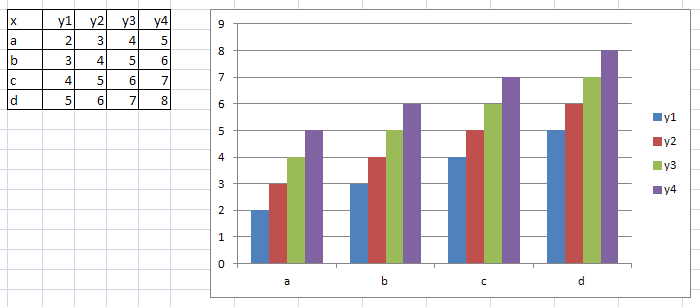- Home
- /
- Programming
- /
- Graphics
- /
- Re: vbar multiple analysis vars
- RSS Feed
- Mark Topic as New
- Mark Topic as Read
- Float this Topic for Current User
- Bookmark
- Subscribe
- Mute
- Printer Friendly Page
- Mark as New
- Bookmark
- Subscribe
- Mute
- RSS Feed
- Permalink
- Report Inappropriate Content
hi, i thought this would be easy but i cannot find a way to do it (in a simple way in sas913).
i want to create a bar chart with multiple analysis vars, like the chart below i created in excel:

how can i do this in sas?
thanks, Bart
- Mark as New
- Bookmark
- Subscribe
- Mute
- RSS Feed
- Permalink
- Report Inappropriate Content
SAS graph is definitely NOT my forte, but the following gets a fairly close result to what you want:
data have;
input x $ y1-y4;
cards;
a 2 3 4 5
b 3 4 5 6
c 4 5 6 7
d 5 6 7 8
;
data need (keep=x time y);
set have;
array thedata(*) y1-y4;
do time=1 to dim(thedata);
y=thedata(time);
output;
end;
run;
proc gchart data=need;
vbar y / discrete
type=sum sumvar=y
group=x
space=0
gspace=4
subgroup=time /* this controls the coloring */
maxis=axis1 /* midpoint axis */
raxis=axis2 /* response/numeric axis */
gaxis=axis3 /* group axis */
autoref /* reflines at every major axis tickmark */
clipref /* put reflines behind the bars */
cref=graycc
legend=legend1
coutline=black
des=""
;
run;
quit;
- Mark as New
- Bookmark
- Subscribe
- Mute
- RSS Feed
- Permalink
- Report Inappropriate Content
thanks i will give this a go.
- Mark as New
- Bookmark
- Subscribe
- Mute
- RSS Feed
- Permalink
- Report Inappropriate Content
Using Art's data, reshape the data by groups and use proc GCHART.
data group;
keep x grp val;
set have;
grp='Y1'; val=y1; output;
grp='Y2'; val=y2; output;
grp='Y3'; val=y3; output;
grp='Y4'; val=y4; output;
run;
proc gchart data=group;
vbar grp / sumvar=val group=x subgroup=grp autoref clipref;
run;
quit;
- Mark as New
- Bookmark
- Subscribe
- Mute
- RSS Feed
- Permalink
- Report Inappropriate Content
And one more variation ...
data my_data;
input groupvar $ y1-y4;
cards;
a 2 3 4 5
b 3 4 5 6
c 4 5 6 7
d 5 6 7 8
;
run;
proc transpose data=my_data out=tran_data;
by groupvar;
run;
data tran_data; set tran_data (rename=(col1=value _name_=category));
label category='Category';
run;
legend1 label=none across=1 position=(right middle) shape=bar(.15in,.15in)
offset=(-10,0);
axis1 label=none minor=none order=(0 to 9 by 1);
axis2 label=none value=none;
axis3 label=none;
pattern1 v=s c=cx4f81bd;
pattern2 v=s c=cxc0504d;
pattern3 v=s c=cx9bbb59;
pattern4 v=s c=cx8064a2;
proc gchart data=tran_data;
vbar category / type=sum sumvar=value
group=groupvar
subgroup=category
space=0
legend=legend1
raxis=axis1
maxis=axis2
gaxis=axis3
noframe
autoref cref=graydd clipref
coutline=same
;
run;
April 27 – 30 | Gaylord Texan | Grapevine, Texas
Registration is open
Walk in ready to learn. Walk out ready to deliver. This is the data and AI conference you can't afford to miss.
Register now and lock in 2025 pricing—just $495!
Learn how use the CAT functions in SAS to join values from multiple variables into a single value.
Find more tutorials on the SAS Users YouTube channel.
SAS Training: Just a Click Away
Ready to level-up your skills? Choose your own adventure.





